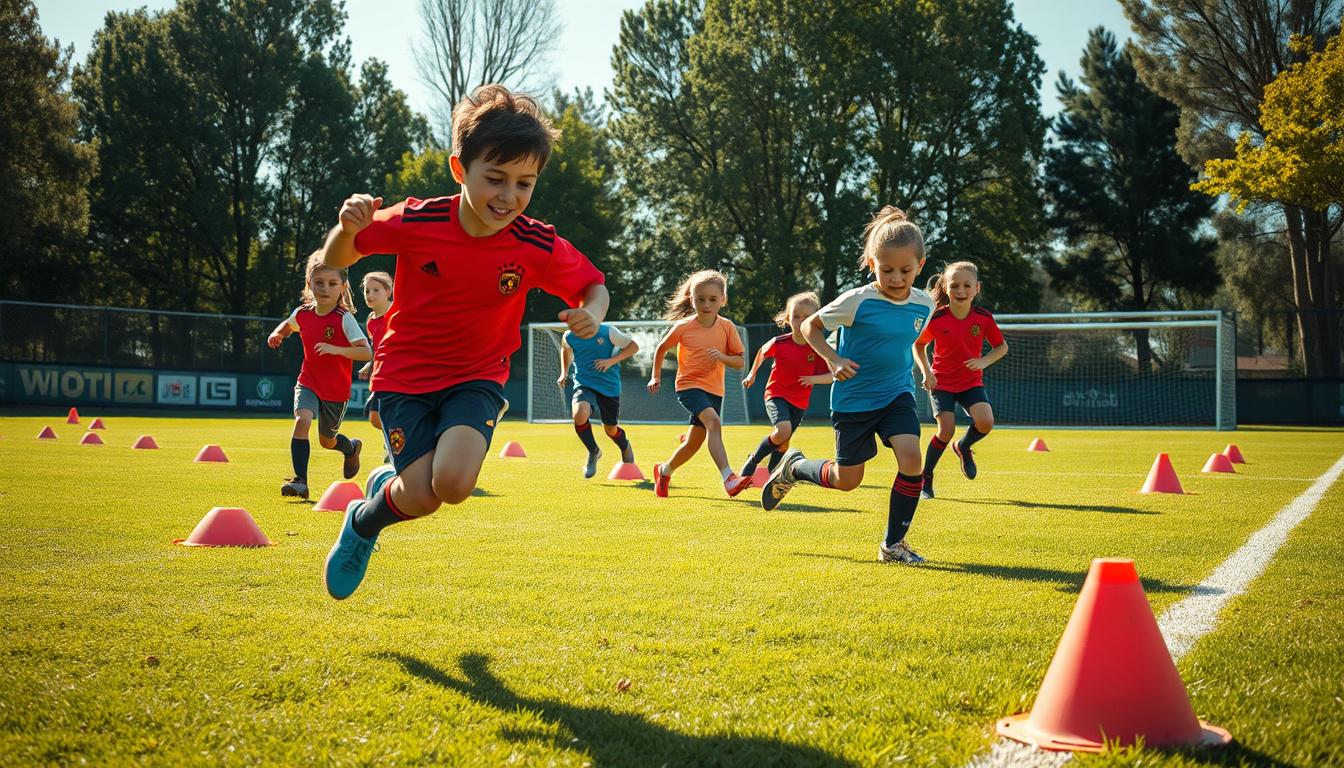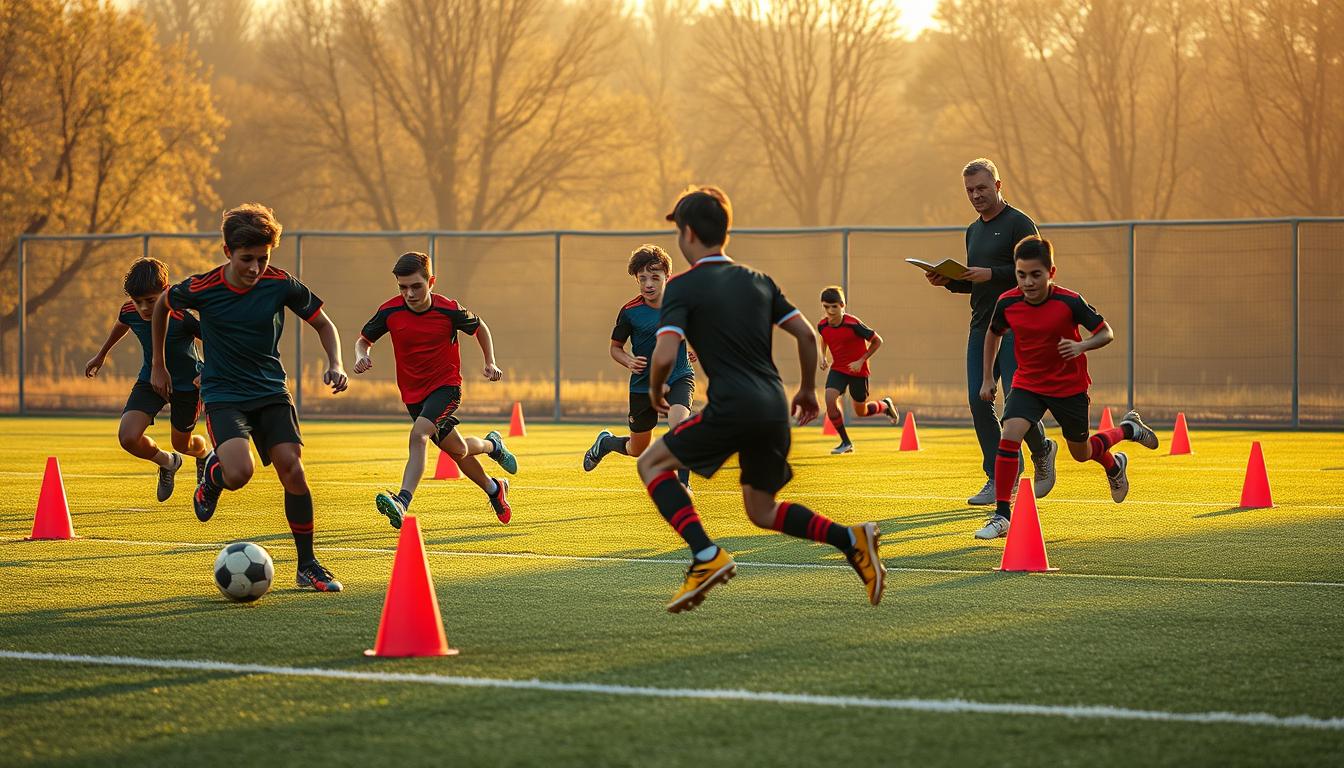Speed Training Plans for Kids Soccer

Want to help your young athlete stand out on the field? Soccer speed training plans aren’t just for pros—they’re game-changers for kids too. Whether it’s explosive sprints or quick directional shifts, building agility early creates a foundation for long-term success. Experts like Lucas Kruel emphasize that focused drills improve coordination, power, and confidence, giving players an edge during matches.
Think about Douglas Costa’s career: his rapid acceleration didn’t happen by accident. Clubs like Juventus use structured routines blending strength exercises with dynamic movements. For young athletes, these methods adapt to boost growth while reducing injury risks. This article breaks down practical techniques—from basic footwork to advanced plyometrics—so you can support their progress.
Why does this matter? Proper development now shapes how they compete later. A well-designed plan doesn’t just build faster players—it nurtures smarter, more resilient ones. Ready to unlock their potential?
Key Takeaways
- Early speed training enhances agility and coordination for young athletes.
- Structured drills improve explosive power, mirroring methods used by professionals.
- Balanced routines support physical growth while minimizing injury risks.
- Expert-backed techniques adapt to both beginner and advanced skill levels.
- Consistent practice builds confidence and decision-making during games.
Pre-Training Essentials
Before lacing up those cleats, there’s critical groundwork every athlete needs. Proper preparation saves time, reduces setbacks, and builds a foundation for consistent growth. Programs like US Youth Soccer’s off-season plans stress health screenings and tailored goals—two pillars that determine how effectively players adapt to new challenges.
Health Check and Preparedness
Start with a full physical evaluation. Coaches recommend checking for lingering injuries or muscle imbalances that could worsen during drills. Pair this with dynamic warm-ups—like leg swings or lateral lunges—to prep joints and boost blood flow. A safe space matters too: clear debris from fields and ensure proper footwear to support quick changes in direction.
Setting Clear Training Goals
What’s your target? Maybe shaving half a second off a 20-yard dash or mastering three new footwork patterns monthly. Write these down and track them weekly. If your child struggles with lateral movements, focus on exercises that enhance side-to-side agility. Studies show athletes with specific objectives improve 30% faster than those without. Adjust routines every 4-6 weeks based on progress.
These steps aren’t just checkboxes—they’re the way to maximize results while keeping sessions fun and sustainable. When you know where you’re starting and where you’re headed, every sprint and pivot becomes purposeful.
Dynamic Warm-Up and Basic Drills
Great practices start long before the whistle blows. A dynamic warm-up primes muscles, sharpens focus, and sets the tone for high-energy sessions. Research shows athletes who properly prepare their bodies improve performance by up to 15% compared to those who skip this step.
Effective Warm-Up Routines
Begin with movement patterns that mimic game actions. Try 8-10 minutes of:
- High knees with arm pumps (activates hip flexors)
- Lateral shuffles (engages glutes and quads)
- Skips with overhead reaches (enhances coordination)
These exercises boost blood flow while reinforcing proper biomechanics. Clubs like Real Madrid integrate similar routines to prep young players for intense drills.
Introductory Speed Drills
Start with short bursts that teach explosive starts. The 5-10-5 shuttle drill works wonders:
| Drill | Focus | Reps |
|---|---|---|
| Quick feet ladder | Foot coordination | 3×30 sec |
| 10-yard sprints | Acceleration | 5x each direction |
| Zig-zag cones | Agility | 2×45 sec |
Focus on quality movement over speed. These foundational skills translate directly to small-sided games where quick decisions matter most. As athletes master these basics, they build the power and control needed for advanced routines.
Implementing Soccer speed training plans
Effective training transforms raw talent into on-field excellence through deliberate practice. Whether working with beginners or seasoned athletes, structured drills create measurable progress. Start with foundational exercises, then gradually introduce complexity to match growing skills.

Step-by-Step Guide to Drills
Begin with ladder drills to sharpen foot coordination. Place 10 cones in a straight line, spaced 2 feet apart. Players sprint through the pattern, lifting knees high while maintaining light steps. Coaches should emphasize quick ground contact—this builds reactive strength for sudden directional changes.
Next, integrate cone zig-zags to improve lateral movement. Set markers at 45-degree angles and have athletes weave through them at 75% intensity. Adjust spacing based on skill level—closer cones challenge advanced players, while wider gaps suit newcomers.
| Drill | Focus | Reps | Adjustments |
|---|---|---|---|
| Ladder Sprints | Footwork Precision | 4×20 sec | Add backward runs |
| Cone Weaves | Hip Flexibility | 3×30 sec | Use single-leg hops |
| Reaction Sprints | Explosive Starts | 6×10 yd | Vary whistle signals |
For older athletes, add resistance bands during sprints. This small change increases power output by 18%, according to a University of Georgia study. Always prioritize form—leaning too far forward or hunching shoulders reduces efficiency.
Coaches can modify any drill by altering distances or adding visual cues. For example, toss a ball mid-sprint to test decision-making under pressure. These tweaks keep sessions engaging while simulating real-game scenarios.
Advanced Speed and Agility Exercises
Elevate your player’s game with drills that push physical and mental boundaries. High-intensity techniques refine explosive power while sharpening split-second decision-making—skills elite athletes like Kylian Mbappé credit for their rapid on-field transitions.
Plyometric and Acceleration Drills
Plyometrics teach the body to generate maximum force in minimal time. Try box jumps: start with 12-inch platforms, focusing on soft landings to protect joints. Progress to depth jumps—stepping off a box and immediately exploding upward—to boost reactive strength.
Acceleration work bridges raw power with game-ready bursts. Attach resistance bands to a waist harness during 10-yard sprints. Dr. Michael Yessis notes this method increases stride frequency by 9% in youth athletes within 8 weeks.
Multi-Directional Movement Techniques
Real matches demand sudden shifts—sideways, backward, diagonal. Set up a T-drill: sprint 10 yards forward, shuffle 5 yards left, then 10 right. Time each attempt while maintaining low hip positioning for optimal mechanics.
Rotational exercises build 360-degree control. Have players pivot around cones while catching tossed balls—this mirrors game scenarios requiring quick movements under pressure. Proper arm swing technique here can boost velocity during directional changes.
| Drill | Focus | Key Benefit |
|---|---|---|
| Lateral Bound Hops | Sideways Power | Strengthens glutes for cutting |
| 5-Second Bursts | Rapid Acceleration | Improves first-step quickness |
| Figure-8 Dribbles | Footwork + Agility | Enhances close control at pace |
Always prioritize form over intensity. Bent knees, engaged core, and eyes forward create efficient movements that translate to faster play. When done right, these methods help young athletes move like pros—powerful, precise, and unpredictable.
Structuring a Complete Training Program
Building a champion athlete requires more than just practice—it demands a smart blend of power, precision, and recovery. By merging strength work with agility drills, young competitors develop the core stability and explosive energy needed for peak performance. Let’s break down how to create routines that keep players thriving all season.
Integrating Strength and Conditioning
Start with three weekly sessions alternating between speed days and strength days. On speed days, focus on 20-yard sprints and ladder footwork. Strength days should include bodyweight squats and medicine ball throws to build functional muscle. Always finish with deceleration drills—like controlled stops after sprints—to protect joints during sudden stops.
Here’s a sample week for ages 10-14:
| Day | Focus | Key Exercises |
|---|---|---|
| Monday | Speed + Agility | Shuttle runs, cone weaves |
| Wednesday | Strength | Plank variations, resistance band rows |
| Friday | Game Simulation | Dribble-and-pivot drills, reaction sprints |
Track progress with timed 40-yard dashes and vertical jump measurements. Programs like those from US Youth Football show athletes improve 23% faster when combining these metrics with weekly goal reviews.
Don’t forget fuel and rest! Hydration and protein-rich snacks aid muscle repair, while 8-10 hours of sleep boost recovery. A balanced plan isn’t just about drills—it’s about creating athletes who excel both on and off the field.
Final Thoughts and Next Moves
Progress on the field starts with smart preparation and ends with measurable results. Every drill, sprint, and cone weave you’ve explored builds toward one goal: helping your athlete outmaneuver opponents while staying injury-free. By combining structured routines with real-time feedback, young players develop sharper instincts and lasting confidence.
Tracking data like sprint times or recovery rates isn’t just for coaches—it’s your secret weapon. Simple tools like stopwatches or apps reveal what’s working, letting you tweak intensity or focus areas weekly. Did those ladder drills shave half a second off their 40-yard dash? Numbers don’t lie.
Experiment freely! Swap cone layouts monthly or challenge them with reaction-based games. The best routines adapt as skills grow, keeping sessions fresh and goals achievable. Set new targets every 6-8 weeks—maybe improving lateral agility or shortening rest times between bursts.
Always circle back to fundamentals: clean technique, adequate rest, and routine evaluations. These elements separate good players from those who dominate tough opponents. Ready to level up? Grab those cones, hit the field, and watch effort turn into excellence.
